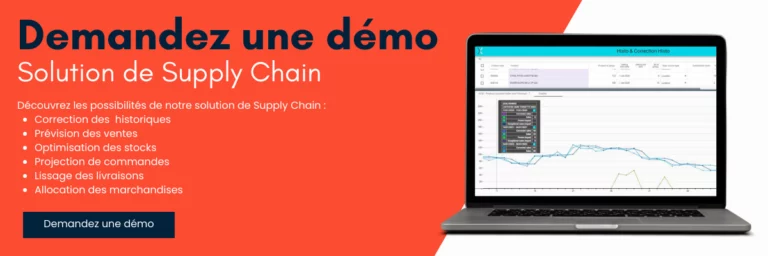Retail Supply Planning
In constant evolution, supply planning and sales forecasting are essential to a company’s success. These two processes are closely linked and play a crucial role in effective supply chain management, customer satisfaction and overall profitability.
In this article, we’ll explore the importance of these two fundamental aspects of retail and how they contribute to business success.

What is Supply Planning ?
Supply planning is the process of determining which products are to be purchased, in what quantities and at what times. This enables production needs to be met while minimizing the costs associated with excessive storage and stock-outs.
Key components of supply planning
- Demand forecast: Estimate the quantity of products that will be needed to meet future customer demand.
- Stock levels Stock levels: Evaluate how much stock needs to be held in reserve to meet orders and deal with unforeseen circumstances.
- Lead time The time it takes to receive products once an order has been placed with the supplier.
Innovation
Here are the steps involved in setting up a supply planning system:
Demand analysis:
- Forecast Forecasting: estimation of future demand based on historical data, market trends, upcoming promotions, etc.
- Order evaluation: Analysis of current and future customer orders.
Assessment of existing stocks :
- Check current stock levels.
- Identify obsolete and slow-moving stock to adjust future orders.
Determining needs :
- Calculation of quantities needed to meet forecast demand, taking into account existing stocks.
- Identification of items to be ordered, their quantities and order dates.
Supplier selection :
- Based on quality, cost, reliability and lead time.
- Negotiation of terms and conditions with selected suppliers.
Placing orders :
- Issue purchase orders and use automated systems to order the necessary stock.
Follow-up and acceptance :
- Monitor order status.
- Receive and check deliveries against purchase orders.
- Manage any returns or problems with suppliers.
Revaluation :
- After receiving stock, check inventory levels.
- Adjust forecasts according to current trends and supplier performance.
Analysis and continuous improvement :
- Evaluate the accuracy of forecasts and the efficiency of the supply planning process.
- Identify areas for improvement to optimize inventory management and reduce costs.
Technology integration :
- Use of inventory management systems and analysis tools to automate and improve process accuracy.
- Regular updating of software and tools to adapt to technological changes and business needs.
Periodical reviews :
- Regular meetings with sales, marketing, production and logistics departments. This ensures smooth coordination and communication.
- Process adjustments based on feedback and past performance.


Why is supply planning so important?
- Cost reduction Good supply chain planning can reduce the costs associated with holding excess inventory or, on the contrary, managing emergencies due to stock-outs. Better sales forecasting avoids the costs associated with discounts and sales to clear excess stock.
- Customer satisfaction : Ensuring that products are available when customers need them is essential to guaranteeing their satisfaction and loyalty.
Customer satisfaction is at the heart of every successful retail business. Effective supply management ensures that products are available when customers need them. Sales forecasting enables us to anticipate customer demand and ensure that the right products are in stock.
- Optimizing resources : Resources, both human and material, are optimally utilized when supplies are well planned.
- Inventory management : Inventory management is a complex task, especially in retail where many different products are involved. Effective supply planning helps maintain a balanced inventory by avoiding shortages and surpluses. This frees up storage space and reduces the costs associated with warehouse management.
- Supply chain optimization : Precise planning helps to optimize the supply chain so as to avoid costly stock-outs, while reducing product surpluses which can lead to unnecessary storage costs.
Social and Environmental Responsibility
Let’s start by defining the key elements of effective supply planning.
Supply planning encompasses the coordination and alignment of production and distribution activities for goods and services to meet customer needs. The ultimate goal is to ensure that you are able to satisfy your customers’ wishes in terms of products, quantities and deadlines.
This process encompasses several key aspects, including demand forecasting, stock level management, raw material procurement, production scheduling and distribution coordination, all with the aim of ensuring that the necessary stock is available in the right place at the right time.
What are the key stages in supply planning?
The supply planning process generally involves the following phases:
- Demand forecasting: This stage is based on predictive analysis aimed at anticipating future demand for specific products. These forecasts guide the entire supply planning process.
- Assessing Current Inventory: Before investing in new inventory, it is essential to accurately know current inventory levels and determine inventory needs based on demand forecasts.
- Supplier Selection and Sourcing: Once you have identified your inventory requirements, it is necessary to source the right suppliers and define effective sourcing strategies to obtain the necessary raw materials and components.
- Distribution Planning: Having the right inventory in the wrong place is as detrimental as not having any at all. Therefore, it is essential to have an effective distribution plan in place to cover your entire business.
- Performance Monitoring: Continuous improvement is crucial, and this involves constantly monitoring supply chain performance. This includes monitoring inventory levels, production schedules and delivery times to ensure supply planning stays on track. It is also crucial to check whether your suppliers are meeting their commitments and take steps to correct any performance gaps.
Why is effective supply planning so important?
The primary objective of supply planning is to ensure that the right products are produced in sufficient quantities, delivered on time and cost-effectively. Effective planning also helps minimize excess inventory, production costs, stock-outs and lost sales, while improving customer satisfaction.
Ultimately, well-thought-out procurement planning should allow you to confidently answer the following essential questions:
- What are my inventory needs? When and how many should I have?
- Where can I find reliable sources of supply? Which suppliers should I favor or avoid?
- How can I minimize costs while maintaining high quality and avoiding delays and shortages?
- How to manage disruptions and variations in demand? How much flexibility do I have to respond quickly to unforeseen changes?
- How to evaluate performance and promote continuous improvement, using key performance indicators to strengthen the supply chain?
Common Supply Planning Challenges
- Market unpredictability : Fluctuations in demand can be difficult to anticipate, especially in an unstable economic environment.
- Supplier Issues : Shipping delays, quality issues, or unexpected price increases can all throw a wrench in the wheels of careful planning.
- Technological Evolution : Businesses must constantly update their systems and processes to stay competitive.
Modern supply planning tools
With the rise of technology, many tools and software have emerged to help businesses with their supply planning efforts.
These tools can analyze historical trends, track inventory levels in real time, and even use artificial intelligence to predict future fluctuations in demand.
Conclusion
Supply planning and sales forecasting are crucial elements for the success of a retail business. These processes enable effective supply chain management, improve customer satisfaction, reduce costs, and help businesses stay responsive to market trends. With the right tools, businesses can successfully navigate the complex landscape of supply. This will therefore ensure the satisfaction of their customers while maximizing their profitability.
Businesses that pay close attention to these aspects will have a significant competitive advantage and be better positioned to thrive in the ever-changing retail world.



